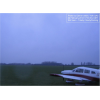نتائج رصد هلال ربيع الآخر لعام 1433 هـ
- توقع رؤية هلال أول الشهر (ربيع الآخر)
- نتائج تحري هلال أول الشهر (ربيع الآخر)
- بداية الشهر الرسمية
- توقع رؤية هلال آخر الشهر (ربيع الأول )
- نتائج تحري هلال آخر الشهر (ربيع الأول )
توقع رؤية هلال أول الشهر (ربيع الآخر)
سيحدث الاقتران المركزي (المحاق المركزي) يوم الثلاثاء 21 شباط / فبراير 2012 في الساعة 22:35 بالتوقيت العالمي بمشيئة الله
إمكانية رؤية الهلال يوم الثلاثاء 21 شباط / فبراير 2012 ويوم الأربعاء 22 شباط / فبراير 2012 موضحة في الأشكال التالية باستخدام برنامج المواقيت الدقيقة باعتماد معيار عودة، بحيث:-
- رؤية الهلال مستحيلة من المناطق الواقعة في اللون الأحمر بسبب غروب القمر قبل غروب الشمس أو/و بسبب حصول الاقتران السطحي بعد غروب الشمس.
- رؤية الهلال ممكنة باستخدام التلسكوب فقط من المناطق الواقعة في اللون الأزرق.
- رؤية الهلال ممكنة باستخدام التلسكوب من المناطق الواقعة في اللون الزهري، ومن الممكن رؤية الهلال بالعين المجردة في حالة صفاء الغلاف الجوي التام والرصد من قبل راصد متمرس.
- رؤية الهلال ممكنة بالعين المجردة من المناطق الواقعة في اللون الأخضر.
- رؤية الهلال غير ممكنة بالعين المجردة أو بالتلسكوب من المناطق غير الملونة، على الرغم من غروب القمر بعد غروب الشمس ومن حصول الاقتران السطحي قبل غروب الشمس، وذلك بسبب قلة إضاءة الهلال و/أو بسبب قربه من الأفق.
- يرجى ملاحظة أن الأشكال أدناه تبين إمكانية رؤية الهلال في المناطق الواقعة بين خطي عرض 60 شمالا و60 جنوبا.
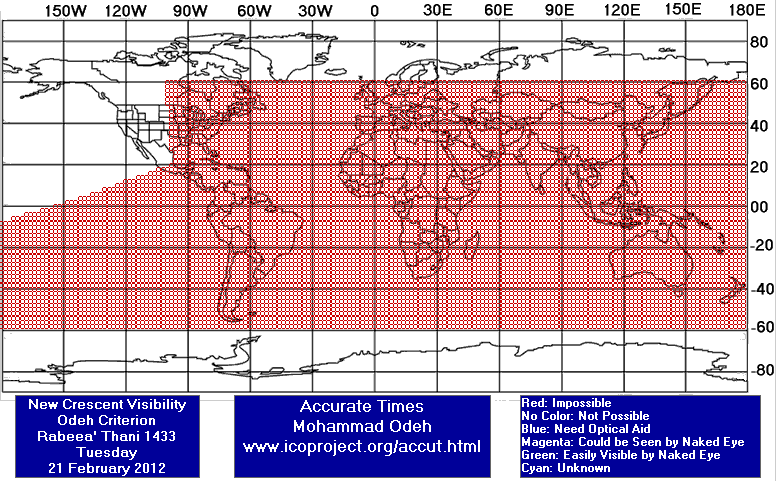
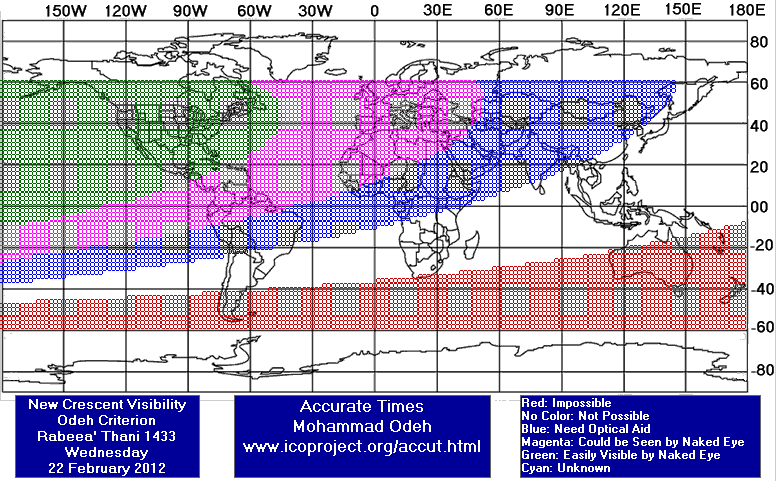
باعتماد التقويم الهجري العالمي المبني على حساب إمكانية رؤية الهلال، فإن بداية الشهر في النطاق الشرقي تكون يوم الخميس 23 شباط / فبراير 2012 ، وبداية الشهر في النطاق الغربي تكون يوم الخميس 23 شباط / فبراير 2012 . الرجاء ملاحظة أن التقويم الهجري العالمي يعتمد على الحسابات المسبقة ( اي لا ينتظر الرصد العملي و رؤية الهلال ) و هو يتبنى معياراً معينا لبدء الشهر الهجري الجديد .و قد تتبنى بلدك او منظمتك معياراً آخر لبدء الشهر لذا فإننا ننصح و بشدة أن يتم الاطلاع عما جاء في صفحة التقويم الهجري العالمي في موقعنا قبل إصدار اي أحكام .
ستضاف نتائج تحري الهلال وبداية الشهر الرسمية في مختلف الدول الإسلامية في هذه الصفحة إن شاء الله فور استلام نتائج الرصد من قبل أعضاء المشروع الإسلامي لرصد الأهلة.
نتائج تحري هلال أول الشهر (ربيع الآخر)
الأربعاء 22 فبراير 2012
الجزائر
وقال عضو المشروع السيد حسين الشيخ عيسى "10 persons were prensent in N'tissa station. Rabee Thani Crescent 1433 crescent was not seen neither by naked eyes nor by binoculars .The western horizon was partly hazy and it was very cold and the Wind Obstructed vision of the Crescent, mercure was seen by naked eyes at 18:59." "
ألمانيا
وقال عضو المشروع المهندس مارتن إليسياسر "Together with two guests from Arabia i started to observe two hours before sunset from the public observatory in munich, germany. We quickly found the crescent with the imaging system in daytime, at around 9° elongation. I could not see the crescent visually while the sun was in the sky, but the imaging system showed the crescent continuously. A few minutes after sunset, i could find the crescent visually with small refractor at 40x magnification. After some time we could also see it with a 10x50 binoculars and with the darkening skies we could finally find it with the naked eye. With the naked eye, the crescent was hardly visible, you really had to know exactly where to look for it. Still, all three of us saw it, so we were satisfied. Later, we had a splendid view of the ISS flying by, using our large reflector."
المملكة العربية السعودية
وقال عضو المشروع السيد صالح الصعب "Atmosphere was very dusty, the sun disappeared in dust at about 3.5 degrees . "
المملكة المتحدة
وقال عضو المشروع المهندس قمر الدين "On Wednesday, 22 February 2012 (29 Rabiul Awwal 1433 AH) many people from throughout UK have attempted to sight the crescent moon (Hilal) of Rabiul Thani after sunset. None of the groups were able to sight the Hilal, as most places were totally cloudy and raining (see attached photo). However, we have received reliable sighting reports (Muhaqaq-Ruyat-Basari) from Morocco Awqaf Ministry. Therefore, the Wifaq/Batley Ulama have decided that the month of Rabiul Awwal 1433 AH will have 29 days and the month of Rabiul Thani 1433 AH will start from Thursday 23 February 2012, Insha-Allah."
الولايات المتحدة
وقال عضو المشروع الدكتور جون كالدويل "poor sky (cloud and smoke) but easy ; 6 deg right of mercury"
وقال عضو المشروع الدكتور جواد تورابنيجاد "I arrived at my sighting location at 6:03 pm EST (sunset: 6:08 pm) and started scanning the mostly cloudy western horizon, using a pair of binoculars (7X50). I stayed there till 6:53 pm, hoping for clear patches to appear to no avail (moonset: 7:10 pm)."
إيران
وقال عضو المشروع السيد علي رضا مهراني "Location: Esfahan, Iran Latitude: 32° 35' 26.78" N Longitude: 51° 38' 14.36" E Elevation: 2080 meters from sea level Time zone: +3.5 Observer & photographer: Alireza Mehrani Date: Wednesday February 22, 2012 (Esfand 3, 1390) Temperature: 2.4 C° (36.32 F°) Wind: 7.2 km/h Humidity: 29% Barometer: 846.9 mb Visibility: 10 km Topocentric and local time values from "Moon Calculator" (Refrac off): Crescent first observation through 15x80 binoculars: Time: 18:14 LT (14:44 UT) Moon Alt: 2° 52' 06" Sun Alt: - (4° 53' 02") Elongation: 8° 28' 04" Rel Azi: 3° 24' 36" Moon Width: 0.17' Moon Phase: 0.66% Moon Age: 16h 09m after conjunction Crescent last observation through 15x80 binoculars: Time: 18:26 LT (14:56 UT) Moon Alt: 0° 26' 41" Sun Alt: - (7° 23' 02") Elongation: 8° 32' 52" Rel Azi: 3° 26' 27" Moon Width: 0.17' Moon Phase: 0.67% Moon Age: 16h 21m after conjunction "
وقال عضو المشروع المهندس سيد رستامي "The crescent was very narrow at 18:10:08 and distinguished in middling of it. The crescent set at 18:14:30."
باكستان
وقال عضو المشروع السيد علام سلطان "Today, on my request, nearly 100 persons ( members of the moon-sighting committees of our institute "JAMIA-TUR-RASHEED" + my friends + their companions) tried to sight the moon all over Pakistan at nearly 17 places but the moon could not be sighted, as it was astronomically expected tonight. It was clear or little hazy at nearly all places. Note 1: Today (Wednesday, 22 February 2012) the conditions of the moon were so defective in the half world especially in Pakistan that according to the all old and new criteria of moon-sighting, there was no solid proof in the history of astronomy to sight such a moon by naked eyes in Pakistan. Note 2: Chairman of central official moon-sighting committee of Pakistan "Mufti Munee-bur-Rahman" told me on my mobile phone that as he did not receive any positive report of moon sighting from all over Pakistan, therefore he officially announced that Thursday 23 February 2012 is the 30th Rabee-ul-Awwal 1433 and 1st Rabee-uth-Thani 1433 will fall on Friday 24th February 2012. Note 3: After some days, inshaallah, a detailed report of this observation will be sent to you or available at www.esnips.com/web/moonnewsofjamiaturrasheed "
بنغلادش
جنوب أفريقيا
ماليزيا
وقال عضو المشروع السيد فردوس مزلان "On Wednesday, 22th February 2012 M equal to 29 Rabi-al-Awwal 1433 H, my friend (Mr. Jamaluddin bin Abu Bakar, Muhammad Ibrahim bin Jamil, and Mohd Hizri bin Md Aris) cannot see the new moon either with telescope or with naked eye at Baitul Hilal, Teluk Kemang, Negeri Sembilan, Malaysia (02:26:43.0 N , 101:51:16.0 E). It because the horizon is very cloudy. So, tomorrow, 23th February 2012 M (Thursday) is still 30th Rabi-al-Awwal 1433 H. ..... "
نيجيريا
الخميس 23 فبراير 2012
أستراليا
الجزائر
وقال عضو المشروع السيد عبد الواحد ديليه "on Thursday 02/23/2012 after maghreb prayer we saw the crescent me and other friends ."
بداية الشهر الرسمية
الخميس 23 فبراير 2012
1 . المملكة العربية السعودية
2 . المملكة المتحدة
3 . إيران
4 . ماليزيا
الجمعة 24 فبراير 2012
1 . أستراليا
2 . باكستان
3 . بنغلادش
4 . جنوب أفريقيا
توقع رؤية هلال آخر الشهر (ربيع الأول )
سيحدث الاقتران المركزي (المحاق المركزي) يوم الثلاثاء 21 شباط / فبراير 2012 في الساعة 22:35 بالتوقيت العالمي بمشيئة الله
إمكانية رؤية هلال آخر الشهر يوم الثلاثاء 21 شباط / فبراير 2012 ويوم الاثنين 20 شباط / فبراير 2012 موضحة في الأشكال التالية باستخدام برنامج المواقيت الدقيقة باعتماد معيار عودة، بحيث:-
- رؤية هلال آخر الشهر مستحيلة من المناطق الواقعة في اللون الأحمر بسبب شروق القمر بعد شروق الشمس أو/و بسبب حصول الإقتران السطحي قبل شروق الشمس.
- رؤية هلال آخر الشهر ممكنة باستخدام التلسكوب فقط من المناطق الواقعة في اللون الأزرق.
- رؤية هلال آخر الشهر ممكنة باستخدام التلسكوب من المناطق الواقعة في اللون الزهري، ومن الممكن رؤية الهلال بالعين المجردة في حالة صفاء الغلاف الجوي التام والرصد من قبل راصد متمرس.
- رؤية الهلال ممكنة بالعين المجردة من المناطق الواقعة في اللون الأخضر.
- رؤية الهلال غير ممكنة بالعين المجردة أو بالتلسكوب من المناطق غير الملونة، على الرغم من شروق القمر قبل شروق الشمس ومن حصول الإقتران السطحي بعد شروق الشمس، وذلك بسبب قلة إضاءة الهلال و/أو بسبب قربه من الأفق.
- يرجى ملاحظة أن الأشكال أدناه تبين إمكانية رؤية الهلال في المناطق الواقعة بين خطي عرض 60 شمالا و60 جنوبا.
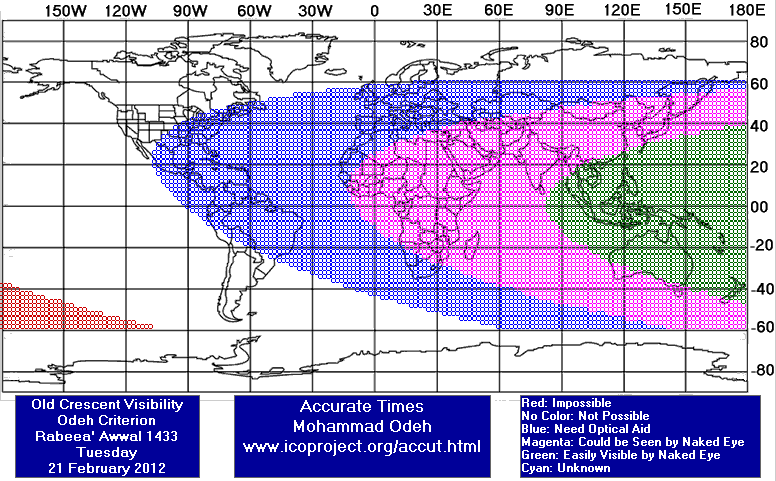
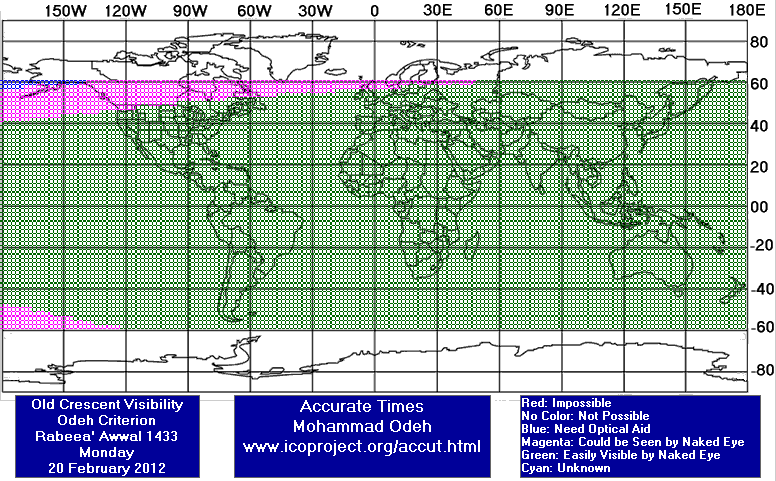
نتائج تحري هلال آخر الشهر (ربيع الأول )
الإثنين 20 فبراير 2012
المملكة المتحدة
وقال عضو المشروع المهندس قمر الدين "On Monday 20 February 2012 I was unable to sight the waning crescent of Rabiul Awwal 1433AH before sunrise from the eastern horizon in York. However, we have received a report from Dr Usama Hasan from London that he has sighted it this morning at 6:35 hrs GMT."
أندونيسيا
وقال عضو المشروع السيد سوجنج رياضي "On Monday, February 20, 2012; I and Mr. Muflih Arisa Adnan from PPMI Assalaam Surakarta tried to observe the old hilal of Rabiul Awwal 1433 AH from Assalaam Observatory in Surakarta and Asy-Syifaa Observatory in Juwiring Klaten. . The Old crescent of Rabiul Awwal 1433 AH was NOT SEEN neither from Surakarta and Klaten, Central Java, Indonesia. The sky was hazy."
الثلاثاء 21 فبراير 2012
الجزائر
وقال عضو المشروع السيد عبد الواحد ديليه "bismi allah errahman errahim in the day of Monday 02/20/2012 i tried to sight the crescent but the sky was totally cloudy so i can't see it. I prepared my self to sight the moon for Tuesday by calculating the astronomical parameters of moon and sun, this day morning the sky was totally cloudy near the horizon so i continued sighting until 07:38 without seeing the crescent .the sun rising time by calculation was 07:19 by cause of cloud i can't see the phenomena. "
ألمانيا
وقال عضو المشروع المهندس مارتن إليسياسر "I observed the old crescent this morning at about 8.8° elongation. The weather was ok, with some haze near the horizon, at -11°C. The seeing was quite bad, which strongly blurred the view of the mountain peaks across the valey where the crescent was due to rize. I tested a combination of inexpensive camera and optics, but found serious issues with the image quality with the crescent repeatedly fading from view. Still, the camera showed the crescent clear enough for about 25 minutes between moonrise and sunrise. I als tried to observe the crescent visually with a small telescope at 60x. Despite being reasonably sure of the position and focus i could NOT spot the crescent visually. I think that the haze and the bad seeing both were responsible for this, plus some problems with the lashed-together instruments. Around noon, we also observed the old crescent with the imaging system at about 7° elongation. The weather was still rather hazy, but the crescent was imaged clearly enough."
الولايات المتحدة
وقال عضو المشروع السيد جيم ستام "Old Moon Crescent Observation Report ====================================== Observed: Tuesday; February 21, 2012 - 06:36 (Local) Location (WGS 84) = Tucson, Arizona (USA) Longitude = 110.68 W Latitude = 32.40 N Elevation = 2240 meters Time Zone = -7.0 hours Surface conditions at location: Temperature = 2 °C Humidity = 45 % Pressure = 30.10 in. Noticeable haze kept the sky from being perfect. Topocentric and local time values from “Accurate Times”: Moonrise (at sea level) = 06:24 Sunrise (at sea level) = 06:52 Time from new moon at 06:36 = -10 hr. 48 min. Moon lag time = 27 min. Relative Altitude = 5.6 degrees Elongation from sun = 5.6 degrees Crescent width = 4 arc seconds Illumination = 0.24 percent I was NOT able to see the crescent, even through a telescope. I was reluctant to report this negative observation, because haze is just like clouds. When either is present, then no real science is obtainable. Seeing no stars near the horizon when pre-pointing the scope pretty much indicated that we were doomed to “failure.” We could not even establish a lower limit for the elongation, which was the secondary objective. We did however see a rocket that was launched (presumably) from White Sands, NM. Observers: Jim Stamm and John Polacheck E-mail Address: StammJim@gmail.com"
أندونيسيا
وقال عضو المشروع السيد سوجنج رياضي "On Tuesday, February 21, 2012; The Old Crescent of Rabiul Awwal 1433 AH was NOT SEEN neither from Surakarta and Klaten, Central Java, Indonesia because the sky was hazy and cloudy."
إيران
نيجيريا
وقال عضو المشروع الدكتور ساني مصطفى "Ideally,the moon could be sighted around 7.22 a.m local time. But the sun was already up. The moon could not be sighted. Why? The physicists should explain the minimum reflected light (luminous intensity) from the sun required for the moon to be sighted. How close is the moon to sun today? The easiest way to predict or know the appearance of the moon is therefore as explained by the Sunna- the moon will not be seen on the eastern horizon for three nights at dawn. Mustapha."
